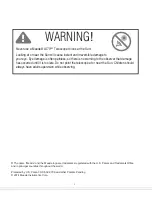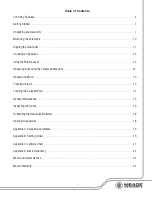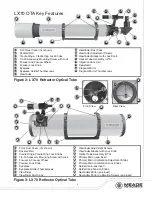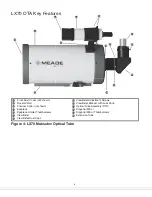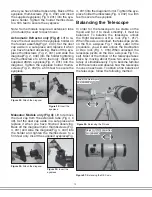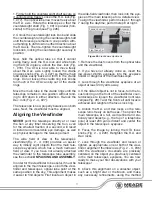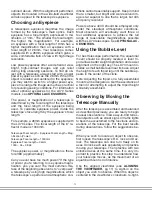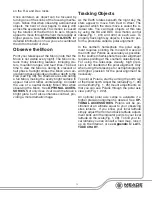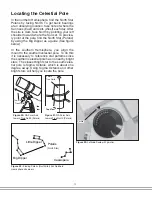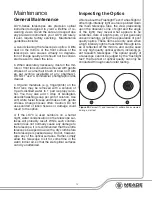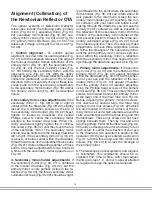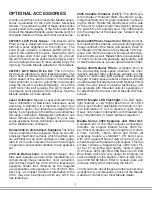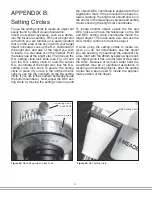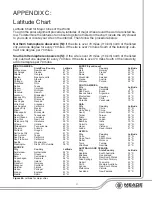
11
1. Firmly hold the counterweight shaft secure so
it cannot swing freely. Loosen the R.A. lock(Fig.
1, #17). The optical tube now moves freely about
the R.A. axis. Rotate the telescope so that the
counterweight shaft (Fig. 1, #9) is parallel (hori-
zontal) to the ground(see Fig. #26).
2. Unlock the counterweight lock knob and slide
the counterweight along the counterweight shaft
until the telescope remains in one position with-
out tending to drift down in either direction about
the RA axis. Then re-tighten the counterweight
lock knob, locking the counterweight securely in
position.
Now, hold the optical tube so that it cannot
swing freely. Lock the R.A. lock and while hold-
ing the OTA in place, unlock the Dec. lock (Fig.
1, #18). The OTA is now able to move freely
about the Dec. axis. Lightly loosen the cradle
ring lock knobs (Fig. 2 - 4, #27) so that the main
tube slides easily back and forth in the cradle
rings. Do not loosen the cradle ring lock knobs
too much or the OTA can slip out of the cradle
rings.
Move the main tube in the cradle rings until the
telescope remains in one position without tend-
ing to drift down in either direction. Re-lock the
Dec. lock (Fig. 2 - 4, #27).
The telescope is now properly balanced on both
axes. Next, the viewfinder must be aligned.
Aligning the Viewfinder
NEVER
point the telescope directly at or near
the Sun at any time! Observing the Sun, even
for the smallest fraction of a second, will result
in instant and irreversible eye damage, as well
as physical damage to the telescope itself.
The wide field of view of the telescope’s
viewfinder(Fig. 2 - 4, #33) provides an easier
way to initially sight objects than the main tele-
scope’s eyepiece, which has a much narrower
field of view. If you have not already attached
the viewfinder to the telescope tube assembly,
see the section
UNPACKING AND ASSEMBLY
.
In order for the viewfinder to be useful, it must be
aligned to the main telescope, so both the view-
finder and telescope’s optical tube point at the
same position in the sky. This alignment makes
it easier to find objects: First locate an object in
the wide-field viewfinder, then look into the eye-
piece of the main telescope for a detailed view.
To align the viewfinder, perform steps 1 through
7 during the daytime; perform step 8 at night.
1. Remove the dust covers from the optical tube
and the viewfinder.
2. If you have not already done so, insert the
low-power 26mm eyepiece into the eyepiece
holder or diagonal of the main telescope.
3. Look through the viewfinder eyepiece at an
object at least 200 yards away.
4. If the distant object is not in focus, turn the fo-
cus lock ring on the front of the viewfinder coun-
terclockwise to loosen the viewfinder front lens
cell(see Fig. 28). Twist the front cell until focus is
achieved and retighten the focus lock ring.
5. Unlock the R.A. and Dec locks so the tele-
scope turns freely on both axes. Then point the
main telescope at a tall, well defined and sta-
tionary land object (e.g., the top of a telephone
pole) at least 200 yards distant and center the
object in the telescope’s eyepiece.
6. Focus the image by turning the OTA focus
knobs (Fig. 2 - 4, #29). Retighten the R.A. and
Dec. locks.
7. Look through the viewfinder and loosen or
tighten, as appropriate, one or both of the view-
finder alignment thumbscrews (Fig. 2 - 4, #35)
until the viewfinder’s crosshairs are precisely
centered on the object you previously centered
in the main telescope’s eyepiece. You are now
ready to make your first observations with your
telescope!
8. Check this alignment on a celestial object,
such as a bright star or the Moon, and make
any necessary refinements, using the method
Figure 28:
Viewfinder adjustments
Focus Lock ring
Focus Lock ring
Front Lens Cell
Front Lens Cell
Alignment
Alignment
screws
screws
Summary of Contents for LX70 Series
Page 1: ...1 Instruction Manual LX70 Series German Equatorial Telescopes...
Page 25: ...25 OBSERVATION LOG...
Page 26: ...26 26 OBSERVATION LOG...
Page 27: ...27 OBSERVATION LOG...


